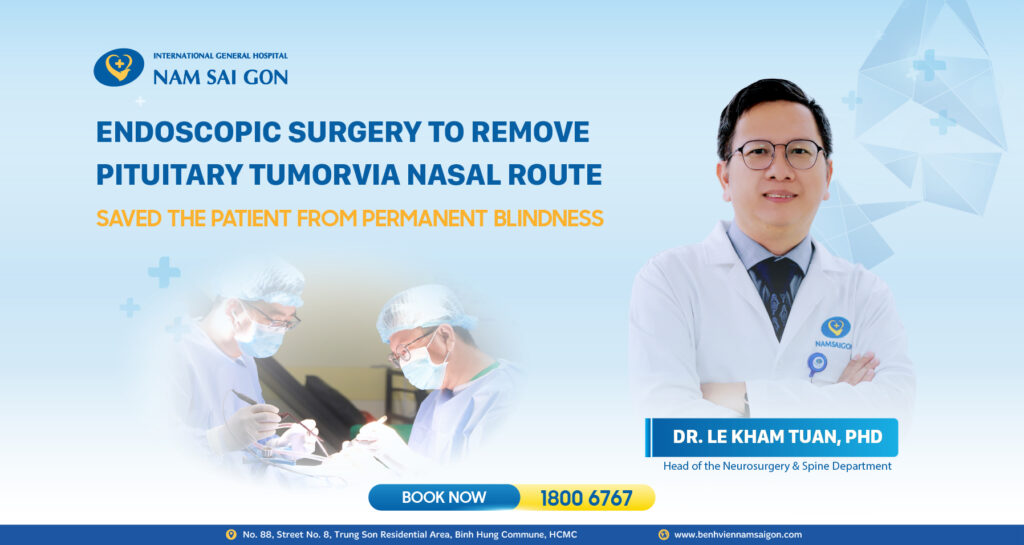MAN NEARLY WENT BLIND DUE TO A SILENTLY PROGRESSING BRAIN TUMOR
-
Author: BỆNH VIỆN ĐA KHOA QUỐC TẾ NAM SÀI GÒN
-
14/05/2025
-
285
It began with headaches and dizziness, then quickly progressed to drooping eyelids and loss of vision in the left eye within just one week. Mr. S. (59 years old, Ho Chi Minh City) was rushed to Nam Sai Gon International General Hospital, where doctors discovered a brain tumor compressing the optic nerve — placing him at serious risk of permanent blindness.
Dr. Le Kham Tuan, PhD, Head of the Neurosurgery & Spine Department, shared that Mr. S. underwent a successful surgery and made a remarkable recovery thanks to endoscopic transsphenoidal pituitary surgery. Before being admitted, Mr. S. had endured persistent headaches and dizziness. Notably, two days before hospitalization, he experienced drooping of the left eyelid — a development that alarmed his family and prompted them to bring him to the hospital.
Initially, doctors diagnosed Mr. S. with a pituitary tumor of uncertain or unknown characteristics — a vague finding that reflected the diagnostic uncertainty regarding the nature of the tumor located in the pituitary gland (a small but essential organ responsible for regulating many vital body functions). To clarify the diagnosis and assess its risk, doctors at Nam Sai Gon International General Hospital ordered further specialized imaging and laboratory tests.
Drooping Eyelid and Blurred Vision – Warning Signs of a Pituitary Tumor
MRI scans revealed a 14×7×22 mm tumor located within and above the pituitary gland, occupying space and compressing the optic chiasm — the crossing point of the optic nerves — which led to eyelid drooping and reduced vision. In addition, the patient’s left pupil showed abnormal dilation and constriction with a weak light reflex — clear signs that the optic nerve was under severe pressure.
The MRI also showed the tumor had a heterogeneous structure and uneven contrast enhancement. The mucosa of both sphenoid sinuses was thickened, indicating surrounding tissue inflammation or tumor-related reaction, which further confirmed the involvement of nearby regions.

Complete Tumor Removal Through Endoscopic Transsphenoidal Surgery
Faced with the risk of the tumor continuing to compress the optic pathway and causing irreversible damage, the surgical team opted for endoscopic transnasal transsphenoidal surgery — a minimally invasive technique performed through the nasal cavity and sphenoid bone (located deep inside the skull). Compared to traditional open brain surgery, this approach minimizes trauma and offers faster recovery.
Because the tumor was directly compressing the optic chiasm and could affect both vision and hormonal regulation, timely surgery was crucial to preserving the patient’s eyesight and restoring endocrine function, Dr. Tuan emphasized.
During surgery, the entire tumor was carefully removed. The surgeons also used a self-adhesive dural patch to seal the sella turcica (the cavity where the pituitary gland sits), helping to prevent cerebrospinal fluid leakage, reduce infection risk, and protect surrounding neural structures. The operation was a great success — not only was the tumor completely excised, but pressure on the optic nerves was relieved, leading to a marked improvement in the patient’s vision.
After surgery, Mr. S. was able to sit up independently, eat normally, and interact clearly. His pre-operative symptoms — visual impairment, headache, and ptosis — improved significantly. Post-surgical assessments showed gradual vision restoration in the left eye, improved pupillary light reflexes, and normalized pupil response.
“Pituitary tumors are relatively common”, Dr. Le Kham Tuan, PhD noted, “but often go undetected without clear symptoms. That’s why it’s essential to seek medical attention early when experiencing persistent headaches, visual disturbances, or unexplained hormonal changes. Early diagnosis leads to better outcomes and reduces the risk of serious complications”.
Nam Sai Gon International General Hospital
No. 88, Street No. 8, Trung Son Residential Area, Binh Hung Commune, Ho Chi Minh City.
Hotline: 18006767
info@nih.com.vn
Last updated: 15:41 22/11/2025






